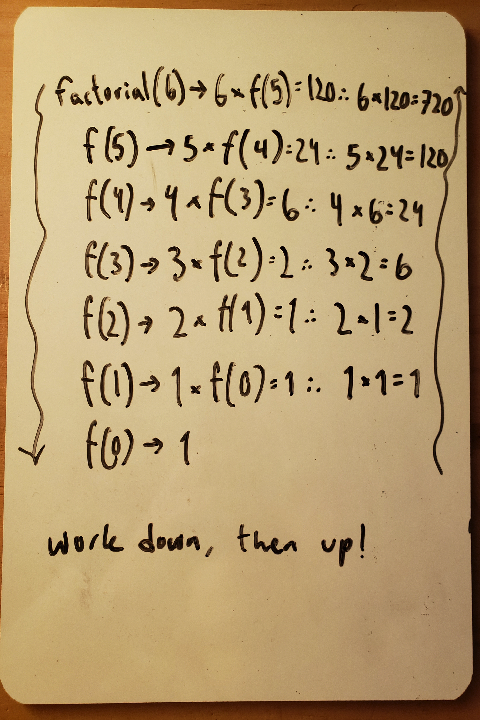Recursion
Introduction: 10.1.1
- Recursion is when a method calls itself
- Recursion which never ends is called
infinite recursion
public void neverEnds() {
System.out.println("This method will never end!");
}
Why use recursion?: 10.1.2
- Recursion is useful when solving problems where the structure of the problem repeats
- If you wanted to know how much space a folder on your computer uses
- You add up the size of all files in your folders, but folders have folders in them
- If you wanted to know how much space a folder on your computer uses
- Recursion can be used to traverse a String, array, and ArrayList, like a loop
- Any recursive solution can be written as a loop
Factorial method: 10.1.3
- A factorial is a good example of a recursive method
- 4! is 4 * 3!; 3! is 3 * 2!; etc.
- To trace a recursive method, use a call stack
- A stack to keep track of what methods were called, and what line they were called from
- Where to return after a method exits
- The main method is at the bottom of the call stack
- A recursive method usually has one condition where it returns a value instead of a recursive call
- This is the base case
- If a method doesn’t have this, it’s infinite recursion
public static int factorial(int val) {
if (val == 0) {
return 1;
} else {
return val * factorial(val - 1);
}
}
Base Case: 10.1.4
- Every recursive method must have at least one
base caseto halt recursion- Usually an if statement to cause the recursion to stop by giving an answer instead of a recursive method call
- The factorial of 0 returns 1 right away, because that is known
Tracing Recursive Methods: 10.1.5
- The
call stackkeeps track of the methods that you have called since the main method- A stack is a way of organizing data that adds and removes items only from the top of the stack
- When you execute method a and it calls method b, the method call is placed in the stack along with where it is being called from
- this tells the runtime where to return when the top of the stack finishes executing
- When method b finishes executing, the runtime pops the method off the stack and returns execution to the next line to be executed in method a
- When a method calls itself, a new method gets added to the top of the call stack
- Execution pauses until the recursive call finishes
- One way to trace a call stack is to go bottom-up
- Start with the beginning call and continue until you reach the base condition
- This is useful for exams

whiteboard debugging ;)
Summary: 10.1.7
- A recursive method is ome which calls itself
- Recursive methods contain at least one base case
- Halts recursion
- Recursive methods contain at least one recursive call
- Each recursive call has its own set of local variables, including formal parameters
- Parameter values capture the progress of a recursive process
- Any recursive solution can be replicated using iteration
- Writing recursive code is outside the scope of the AP Exam
- Recursion can be used to traverse a String, array, or ArrayList

This work is licensed under a Creative Commons Attribution-NonCommercial-ShareAlike 4.0 International License.
This was adapted from the CS Awesome curriculum, which was created by
Barbara Ericson, Beryl Hoffman, and many other CS Awesome contributors. All rights reserved.
CS Awesome is licensed under CC BY-NC-SA 4.0.